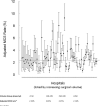Perioperative mechanical circulatory support in children: an analysis of the Society of Thoracic Surgeons Congenital Heart Surgery Database
- PMID: 24246548
- PMCID: PMC3926808
- DOI: 10.1016/j.jtcvs.2013.09.075
Perioperative mechanical circulatory support in children: an analysis of the Society of Thoracic Surgeons Congenital Heart Surgery Database
Abstract
Objectives: Analyses of mechanical circulatory support (MCS) in pediatric heart surgery have primarily focused on single-center outcomes or narrow applications. We describe the patterns of use, patient characteristics, and MCS-associated outcomes across a large multicenter cohort.
Methods: Patients (aged <18 years) in the Society of Thoracic Surgeons (STS) Congenital Heart Surgery Database (2000-2010) were included. The characteristics and outcomes of those receiving postoperative MCS were described, and bayesian hierarchical models were used to examine variations in the adjusted MCS rates across institutions.
Results: Of 96,596 operations (80 centers), MCS was used in 2.4%. The MCS patients were younger (13 vs 195 days, P < .0001) and more often had STS-defined preoperative risk factors (57.2% vs 32.7%, P < .0001). The operations with the greatest MCS rates included the Norwood procedure (17%) and complex biventricular repairs (arterial switch, ventricular septal defect, and arch repair [14%]). More than one half of the MCS patients did not survive to hospital discharge (53.2% vs 2.9% of non-MCS patients; P < .0001). MCS-associated mortality was greatest for truncus arteriosus and Ross-Konno operations (both 71%). The hospital-level MCS rates adjusted for patient characteristics and case mix varied by 15-fold across institutions, with both high- and low-volume hospitals having substantial variation in MCS rates.
Conclusions: Perioperative MCS use varied widely across centers. The MCS rates were greatest overall for the Norwood procedure and complex biventricular repairs. Although MCS can be a life-saving therapy, more than one half of MCS patients will not survive to hospital discharge, with mortality >70% for some operations. Future studies aimed at better understanding the appropriate indications, optimal timing, and management of MCS could help to reduce the variation in MCS use across hospitals and improve outcomes.
Keywords: 20; 25; 27; ECMO; ELSO; Extracorporeal Life Support Organization; MCS; STS; Society of Thoracic Surgeons; extracorporeal membrane oxygenation; mechanical circulatory support.
Copyright © 2014 The American Association for Thoracic Surgery. Published by Mosby, Inc. All rights reserved.
Figures



References
-
- Wolfson PJ. The development and use of extracorporeal membrane oxygenation in neonates. Ann Thorac Surg. 2003 Dec;76(6):S2224–9. - PubMed
-
- Almond CS, Singh TP, Gauvreau K, Piercey GE, Fynn-Thompson F, Rycus PT, et al. Extracorporeal membrane oxygenation for bridge to heart transplantation among children in the United States: analysis of data from the Organ Procurement and Transplant Network and Extracorporeal Life Support Organization Registry. Circulation. 2011 Jun 28;123(25):2975–84. - PubMed
-
- Wolf MJ, Kanter KR, Kirshbom PM, Kogon BE, Wagoner SF. Extracorporeal cardiopulmonary resuscitation for pediatric cardiac patients. Ann Thorac Surg. 2012 Sep;94(3):874–9. discussion 879-80. - PubMed
-
- Delmo Walter EM, Alexi-Meskishvili V, Huebler M, Loforte A, Stiller B, Weng Y, et al. Extracorporeal membrane oxygenation for intraoperative cardiac support in children with congenital heart disease. Interact Cardiovasc Thorac Surg. 2010 May;10(5):753–8. - PubMed
-
- Jacobs ML, Mavroudis C, Jacobs JP, Tchervenkov CI, Pelletier GJ. Report of the 2005 STS Congenital Heart Surgery Practice and Manpower Survey. Ann Thorac Surg. 2006;82:1152–8. - PubMed
Publication types
MeSH terms
Grants and funding
LinkOut - more resources
Full Text Sources
Other Literature Sources
Medical

